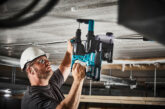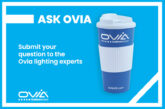
The team at V-TAC looks at why LED floodlights represent the future for electrical installers.
Since its inception in 2009, V-TAC has been steadily making LED lighting solutions more accessible.
In 2016, the company debuted LED floodlights that featured 80 Lm/W. In 2017, as part of its sustainability goals, V-TAC unveiled solar floodlights for the EU and UK markets.
The following year, it further improved on its product range with the Samsung sports floodlights (120Lm/W), whilst the Super Bright series (160Lm/W) and updated models of the Solar floodlights were introduced last year.
Watt’s the difference?
You may have noticed the use of Lumens per Watt (Lm/W) instead of just Watts (W). That’s because Watts is no longer an accurate measure of brightness.
In the days of incandescent lighting, bulbs came in standard 16 Lm/W, hence the unit ‘Watt’ indicated the brightness. Today, with the emergence of LED floodlights, companies like V-TAC now produce 160 Lm/W products, with Metal Halide floodlights producing 75-100 Lm/W and Halogen and High Pressure Sodium floodlights having their own Lm/W range.
A higher wattage no longer means brighter light, making the unit ‘Watt’ a redundant measurement of brightness. However, with the Lumens per Watt measurement, all you need to know is that a floodlight with a higher Lm/W value requires lesser energy to produce bright light, making it more energy efficient.
So why is V-TAC convinced that LED floodlights are the future?
LED vs Halogen
Halogen lights are terribly inefficient. Estimates suggest that swapping an existing halogen floodlight with an LED counterpart could cut energy consumption by up to 65%.
Additionally, 80% of the energy consumed by a halogen floodlight is dissipated as heat. This presents a safety hazard. LED floodlights, on the other hand, produce 80% less heat. They also last up to 30,000 hours – requiring little maintenance – while a halogen floodlight may last 15,000 hours if maintained regularly.
Another point in favour of LED floodlights is that they dissipate light less than halogen floodlights, making them brighter and better at concentrating light in a single direction.
LED vs High Pressure Sodium
High Pressure Sodium floodlights are the closest rivals to LED floodlights – in terms of efficiency. A good HPS floodlight can offer the same Lm/W as an LED floodlight. However, LEDs last longer: 30,000 hours vs 24,000 hours.
An important factor is that HPS floodlights can be slow to switch on, often taking as long as ten minutes while LEDs light up in a fraction of a second. HPS also requires frequent monitoring and regular maintenance for top performance while LED floodlights require little or no maintenance.
LED vs Metal Halide
LED floodlights are twice as efficient as Metal Halides variants. A 100W V-TAC LED floodlight can offer 120 Lm/W while Metal Halide floodlights require 200W for the same output.
Moreover, Metal Halides will last for around 15,000 hours and blown bulbs are very common during the lifespan of this type of lamp. Similar to HPS floodlights, Metal Halide floodlights take 10-15 minutes to start up while LEDs reach maximum brightness in less than a second.
The bottom line?
By modernizing floodlight systems with high-efficiency industrial LED floodlights, companies could see energy savings of up to 90% over conventional systems.
Get more details on V-TAC’s range of LED floodlights by clicking here









